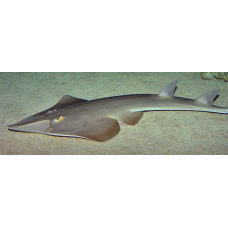Latin name
Rhinobatos rhinobatos
Other names
Rhinobatos rhinobatos
Identification
Very similar in appearance to the blackchin guitarfish (Glaucostegus cemiculus), but generally smaller, with larger eyes, more widely spaced rostral ridges, a longer anterior nasal lobe, and a wider posterior nasal flap. The rostral ridges are widely spaced along their entire length. The anterior nasal flap reaches the inner nostril angle, the posterior nasal flap is broad. Spiracle with two moderately developed folds, the outer one more convex. Spines are relatively small, located along the inner margin of the orbits, between the spiracles, on the shoulders, and along the midline of the disc and tail.
Features of fish fins
Dorsal spines (total): 0; Anal spines: 0; Anal soft rays: 0.
Fish colouring
The back is khaki-brown and the underside is white.
Distribution
They inhabit the North Atlantic from the Bay of Biscay to Angola and the southern Mediterranean.
Habitat
It is a bottom dwelling fish. It inhabits sandy and muddy bottoms, from the intertidal zone to a depth of about 100 meters. Sometimes near rocky reefs.
Size
Can grow to a length of about 147 cm (58 inches), but a more normal length is about 80 cm (30 inches). Maximum declared weight: 26.6 kg.
Behavior
The fish move slowly just above the seafloor, sometimes resting on sand or mud and half covered by sediment.
Food and feeding habits
Common guitarfish feed on crustaceans, other invertebrates and fish.
Reproduction
It is an oviparous fish that produces one or two broods of live calves each year, with four to ten fish in each brood. The gestation period is approximately four months. The young develop inside the female and are nourished first by the yolk sacs and then by the mother's uterine secretions.
Fishing
This species lives near the coast and breeds in shallow waters. This makes it vulnerable. It is caught throughout most of its range, mainly as bycatch. Local fishermen catch common guitarfish with gillnets.
Relationship with a person
The meat of these fish is salted and exported, and the fins are sold in Asia.
| Classification | |
| Phylum | Chordata |
| Class | Chondrichthyes |
| Squad | Rhinopristiformes |
| Family | Rhinobatidae |
| Genus | Rhinobatos |
| Species | R. rhinobatos |
| Features | |
| Conservation status | Critically Endangered |
| Habitat | Bottom |
| Life span, years | No information |
| Maximum body weight, kg | 26,6 |
| Maximum length, cm | 147 |
| Sailing speed, m/s | No information |
| Threat to people | Edible |
| Way of eating | Predator |
Common guitarfish
Tags: common guitarfish



